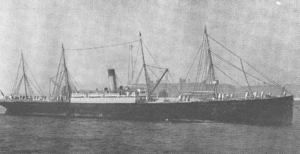SS Bovic facts for kids
class="infobox " style="float: right; clear: right; width: 315px; border-spacing: 2px; text-align: left; font-size: 90%;"
| colspan="2" style="text-align: center; font-size: 90%; line-height: 1.5em;" | 
|} The SS Bovic was a large steamship built in Belfast by a company called Harland and Wolff. It was made for the White Star Line, which owned many famous ships.
Early Life of the Bovic
The SS Bovic was launched into the water on June 28, 1892. It was finished and ready to sail by August 22, 1892. Just a few days later, on August 26, 1892, it made its first big trip. It sailed from Liverpool, England, all the way to New York City in the United States.
The ship was first designed to carry livestock, like cattle and horses, across the Atlantic Ocean. It could carry about 1,050 cattle on its upper deck. It also had special areas for horses. Even though it was mainly for animals, it could carry a small number of passengers too. Later, it was changed to carry more people and became a passenger ship.
Changes and War Service
In February 1914, the Bovic had a special change. All four of its tall masts were made shorter. They were cut down to be the same height as its funnels. This was done so the ship could fit under the bridges of the Manchester Canal.
During World War I, the Bovic had a close call. On August 19, 1915, it was sailing near the coast of southern Ireland. It was almost attacked by a German U-boat (a type of submarine) called U-24. This same submarine had already sunk four other ships in the area that day. The Bovic was chased by the submarine, but it managed to escape safely.
In April 1917, the ship was taken over by the government for war service. This meant it helped with the war effort.
Later Years and Retirement
After the war, the Bovic went back to working for the White Star Line in 1919. In 1921, it joined the Manchester Joint Service, which was a group of ships working together.
In January 1922, the ship was sold to a different company called the Leyland Line. When it was sold, its name was changed to Colonian. Its masts were also put back to their original, taller height. The Colonian continued to sail until 1928. That year, it was taken to Rotterdam and taken apart for scrap.
| History | |
|---|---|
| Name |
|
| Owner |
|
| Builder | Harland and Wolff, Belfast |
| Yard number | 252 |
| Launched | 28 June 1892 |
| Completed | 22 August 1892 |
| Maiden voyage | 26 August 1892 |
| Fate | Scrapped, 1928 |
| General characteristics | |
| Tonnage | 6,583 GRT |
| Length | 470 ft (143.3 m) |
| Beam | 53 ft (16.2 m) |
| Depth | 35.6 ft (10.9 m) |
| Propulsion | 2 × reciprocating steam engines, 2 screws |
| Speed | 13 knots (24.1 km/h) |

